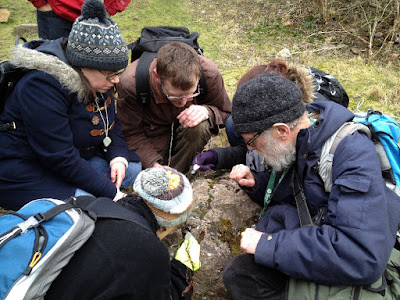We began underneath the church, out of the way of the mixed March weather, and got stuck in to examining lichens.
Frances gave us an information-packed presentation including air monitoring stations in Edinburgh:
A visual demonstration of the structure of lichen: the substrate such as a tree or rock (left), the photosynthesising algae producing food (centre), and the fungus providing shelter and structure (right):
The biodiversity value of lichen, from Tardigrades to Reindeer, Stick-insects camoflage to birds' nests:
Then we got down to using hand-lenses to examine the different structures of lichens which grow on trees
To find ways to describe them with made-up "common names" - the best was "Washed-out black horned splat lichen".
And to classify them into crusty (left), leafy (centre), and bushy (right):
Outdoors, we discussed air pollution, especially particulate pollution which is far smaller than the width of a hair (yep I was so busy taking the photo I didn't write down the statistic). Poor air quality causes a huge range of health problems for us, and shortens lifespan significantly.
Lichens are particularly sensitive to pollution, as they have no skin like a plant or animal, but absorb everything directly from the air around them. And, in a low-lying, sheltered corner below Lothian Road and Princes Street, we didn't find a single crusty, leafy or bushy lichen in St John's Churchyard. There is plenty of work to be done on air quality at the West End of Edinburgh.
However, nearby in West Princes Street Gardens, slightly further from Lothian Road and less sheltered by walls so there was more air movement, we did find plenty of crusty lichens on the trees. This showed both how useful the technique was and what a difference air quality made to lichen biodiversity over a very short distance.
Frances sent us away with a challenge to take the Lichen Pledge, to take some action on improving air quality for lichens and for us. There are all kinds of things one could do, perhaps most importantly to pass on the knowledge we gained by taking a local group to survey lichen in another part of the city. My suggested challenge, as organiser of Wild Reekie and co-ordinator of the Wildlife Proclamation campaign, is to come along to our Elections Nature Café on 6 April, tell our prospective MSPs about the connection between lichen and air pollution, and make sure your they have signed the Wildlife Proclamation: “If elected I undertake to work to restore Scotland’s nature.”
Huge thanks to Frances for running a brilliant workshop. We were privileged to be the first group to experience it: she has a few more coming up so catch them if you can! Email her at F.Stoakley@rbge.ac.uk if you would like details of when these are.
"Thank you Frances, your knowledge, enthusiasm and doability is a joy to behold. I'm fired up for the survey, and intend to help stoke up local concern."
"Really enjoyed that, and will help me share my interest with others. I can also do the survey locally and feed it into a growing concern locally about air pollution."Follow the Wild Reekie Meetup group for details of future events. You can follow Eleanor Harris on twitter @eleanormharris.

































